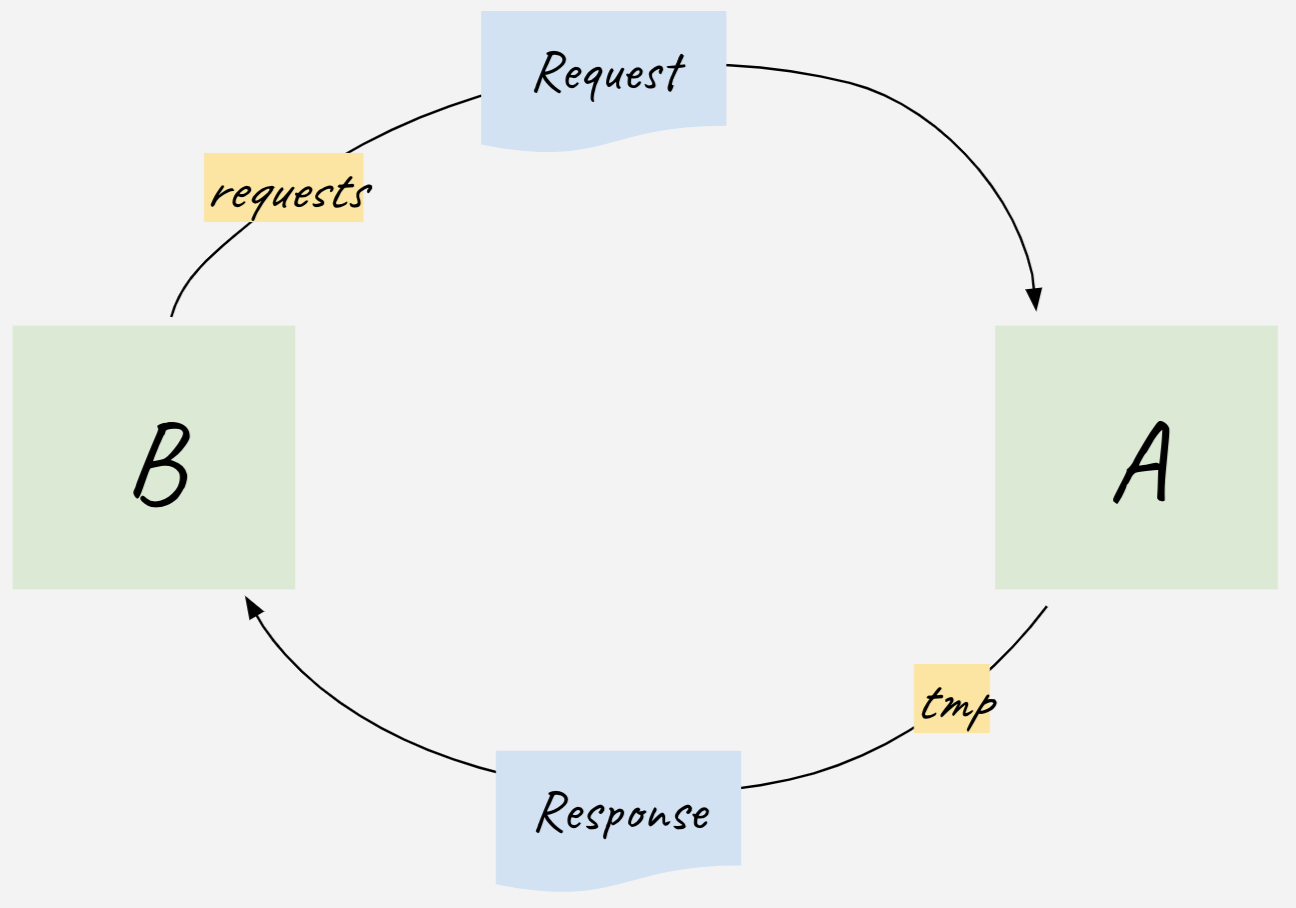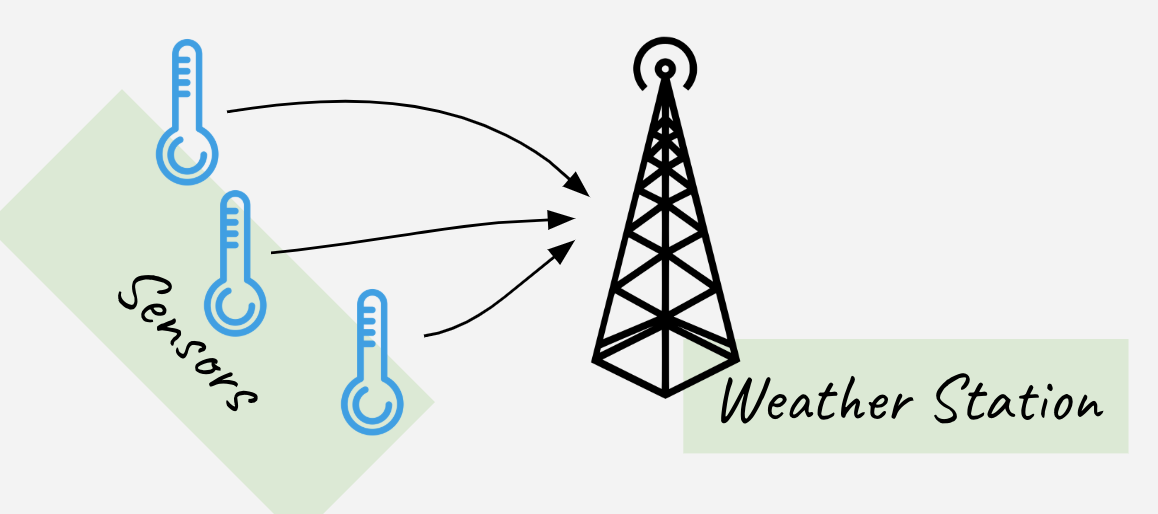Introduction
If you’re writing concurrent code in Crystal, chances are you’re relying on Channels to pass information between Fibers. This works very well when dealing with one-way communication - i.e. when the information flows in one direction only - but probably leaves you wondering how to pass information back and forth between fibers.
In this article, we show a simple pattern to achieve two-way communication between fibers, and then iterate over it, to make it more user-friendly.
Core idea
Let A and B be two fibers, where A holds information that B wants.
B sends a request to A over a channel requests. A then sends a response back via a temporary channel tmp.

Now, you might be wondering: “where does the tmp channel come from?”
Here is the trick, it’s B that creates tmp and wraps it in the Request object.
The following code illustrates the exchange.
|
|
Notice how fiber B
- encapsulates the
tmpchannel inside aRequestobject (line 16) - sends the request to fiber
Aover therequestschannel (line 17) - then calls
receiveontmp(line 18)
Meanwhile, fiber A
- loops through all the requests (line 8)
- extracts the return channel
tmpfrom theRequest(line 9) - sends the
Responseovertmp(line 10)
Runtime considerations
In the above, A and B synchronise twice, with reversed receiver/sender roles, once on requests, and once on tmp - where, likely, B will be waiting for A to return a Response.
A good approximation for the total runtime of fiber B is going to be
- the time spent waiting for
Ato receive fromrequests - + the time spent by
Ato compute theResponse
Case study: IoT weather station
Let’s apply this abstract idea to a sample problem. Imagine we have a collection of temperature sensors sending data to a weather station.

In the following code, we model the weather station as a fiber, and simulate 5 sensors sending data concurrently, every few milliseconds.
alias StationState = Hash(Int32, Float64)
record SetTemperature, id : Int32, temperature : Float64
requests = Channel(SetTemperature).new
spawn(name: "weather_station") do
current_temperatures = StationState.new
loop do
reading = requests.receive
puts "received #{reading}"
current_temperatures[reading.id] = reading.temperature
end
end
# simulate sensors
5.times { |i|
spawn(name: "sensor_#{i}") do
loop do
reading = SetTemperature.new(i, rand)
requests.send reading
sleep rand
end
end
}
sleep # suspend Main fiberYou can run this code yourself. The output should be similar to the following.
received SetTemperature(@id=4, @temperature=0.261551478436086)
received SetTemperature(@id=1, @temperature=0.5216787094023495)
received SetTemperature(@id=2, @temperature=0.07117116427891625)
...
We now want to give an operator the ability to retrieve the latest temperature readings at any point in time. Let’s apply the pattern we’ve seen above.

First, we need to define a new request message (or command) wrapping a channel for the weather station to return its state.
record GetTemperatures, return_channel : Channel(StationState)Then, we have to update the weather station’s request channel and processing loop to support both SetTemperature and GetTemperatures commands.
requests = Channel(SetTemperature | GetTemperatures).new
spawn(name: "weather_station") do
current_temperatures = StationState.new
loop do
case command = requests.receive
when SetTemperature
current_temperatures[command.id] = command.temperature
when GetTemperatures
command.return_channel.send current_temperatures
end
end
endWe can now retrieve the current temperatures following the pattern we saw earlier:
tmp = Channel(StationState).new
requests.send GetTemperatures.new(tmp)
temperatures = tmp.receiveLet’s put this all together, simulating an operator querying the weather station every now and then
alias StationState = Hash(Int32, Float64)
record SetTemperature, id : Int32, temperature : Float64
record GetTemperatures, return_channel : Channel(StationState)
requests = Channel(SetTemperature | GetTemperatures).new
spawn(name: "weather_station") do
current_temperatures = StationState.new
loop do
case command = requests.receive
when SetTemperature
current_temperatures[command.id] = command.temperature
when GetTemperatures
command.return_channel.send current_temperatures
end
end
end
# simulate sensors
5.times { |i|
spawn(name: "sensor_#{i}") do
loop do
reading = SetTemperature.new(i, rand)
requests.send reading
sleep rand
end
end
}
# simulate operator
spawn(name: "operator") do
loop do
tmp = Channel(StationState).new
requests.send GetTemperatures.new(tmp)
temperatures = tmp.receive
puts "received #{temperatures}"
sleep 2 * rand
end
end
sleep # suspend Main fiberIf you run this yourself, the output should look something like
received {0 => 0.8755427230041936, 1 => 0.9284330205519311, 2 => 0.5796278817786711, 3 => 0.7269647270575272, 4 => 0.005449870508358435}
received {0 => 0.6971840652241449, 1 => 0.563615359462064, 2 =>0.1376840269887423, 3 => 0.8042644922805047, 4 => 0.11204561419785454}
...
We have achieved what we wanted, a thread-safe, two-way communication between fibers, but we have added quite a lot of accidental complexity to our code, in the process.
Wouldn’t it be great if weather_station users didn’t have to know about commands and channels to interact with it?
Now that we have a better grasp on the underlying idea, can we make the pattern a bit more user-friendly?
Thread-safe, fiber-powered classes
In the series Live coding a URL checker in Crystal, we took the idea above a step further, and defined a thread-safe statistics aggregator class that keeps track of successful and failed HTTP requests, and also exposes a method to retrieve the statistics on demand. The class exposes a clean API, and hides the implementation details that make write and read operations thread-safe. You can watch the recording of the session here:
Let’s apply the same pattern to our weather station fiber. We’ll hide the implementation details of this thread-safe, stateful fiber, and turn it into a thread-safe class in three steps.
-
We encapsulate records, aliases and requests channel in a
WeatherStationclass.class WeatherStation alias StationState = Hash(Int32, Float64) private record SetTemperature, id : Int32, temperature : Float64 private record GetTemperatures, return_channel : Channel(StationState) @requests = Channel(SetTemperature | GetTemperatures).new # ... end -
We spawn the weather station fiber inside the initialize method. Notice how
current_temperaturesis now an instance variable initialized at creation time.class WeatherStation # ... def initialize @current_temperatures = StationState.new spawn(name: "weather_station") do loop do case command = @requests.receive when SetTemperature @current_temperatures[command.id] = command.temperature when GetTemperatures command.return_channel.send @current_temperatures end end end end # ... end -
Finally, we provide convenience methods to set and retrieve temperatures. This is the public API of our
WeatherStationinstances.class WeatherStation # continued def set_temp(sensor_id : Int32, temperature : Float64) @requests.send SetTemperature.new(sensor_id, temperature) end def get_temps : StationState Channel(StationState).new.tap { |return_channel| @requests.send GetTemperatures.new(return_channel) }.receive end end
This is it! Now we can safely read from and write to a weather station concurrently, without having to care for the implementation details. Furthermore, from the point of view of the caller, each method call is synchronous, which should make reasoning about the code simpler.
You can find a working example of the weather station simulation here.
Thanks for reading, I hope you found this useful. You can share your ideas on writing performant, thread-safe code in the comments section below.